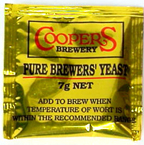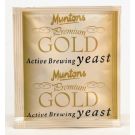'Home-Made' Root Beer
| Hires
Root Beer The first documented evidence of the production of "root beer" was in the American colonies. Historians often credit Charles Hires with creating the root beer flavor we know today, but it is more likely that his version was just more popular. Here is a list of ingredients and countries from a 1922 pamphlet about Hires Root Beer.
|
||
| Birch Bark - United States, New England | Chirreta – India | |
| Dog Grass – Germany | Ginger – Africa | |
| Ginger – China | Ginger – Jamaica | |
| Hires special plant | Hops – United States, Northwest | |
| Juniper Berries – Italy | Licorice – Spain | |
| Licorice – Russia | Sarsaparilla – Honduras | |
| Sugar – Cuba | Vanilla – Mexico | |
| Wintergreen – United States, North Carolina | Yerba Mate, Brazil | |
|
The primary element
in the root beer flavor we know today is wintergreen. |
||
|
HOW TO MAKE ROOT BEER FROM EXTRACT Step #1 - Buy some root beer extract. Don't get that stuff on the grocery store shelves, but go to your brewing supply store. . A quality root beer extract is Hop Tech . They have three variations of root beer extract, all made from natural ingredients. Their web site is at http://homemadesodacompany.com. Many homebrewing supply stores carry root beer extract, and the most common brand is the "Homebrew" brand by Rainbow Flavors. It is also possible to find 'Stolfus Root Beer Extract' from many of the Amish grocery stores. Step #2 - Follow the instructions on the extract bottle. (The instructions for the Rainbow extracts are here.) Generally it is something like dissolving 4 pounds of sugar into 5 gallons of boiling water, and then adding the extract. Feel free to experiment by adding/subtracting a little sugar/extract. Nor do you have to stick with plain old table sugar (sucrose, made from sugar cane and/or beets). You can use corn syrup, which may produce a cleaner taste than table sugar when it goes through the fermentation process (this is why brewers sometimes use it when making beer). You can also try fructose, which is sweeter than other sugars, and this means you can use less sugar to produce the same sweetness with fewer calories (also used by brewers). Furthermore, if calories are a factor, then you might also want to use a combination of Sweet-n-Low or asparatame (Nutrasweet, Equal) and fructose to further reduce calories - it will taste 1000% better than store bought low calorie root beer. You might also want to experiment with honey, molasses, brown sugar, or malt extract (maltose) as a sweetener and flavoring component. Water is also important, if you don't like the way your tap water taste, then use bottled water (but not distilled water). Step #3 - Fermentation time. This section assumes you are going to ferment your root beer, but it is also possible to force carbonate instead. For right now though, we'll just stick to fermentation. It is the process of fermentation that puts the little bubbles, carbon dioxide, into the root beer. It is also pretty simple to accomplish. Pour your flavored sugar water into a bucket that can be covered, and then add a package of ale yeast when the liquids temperature has dropped down to warm (about 75 degrees F.). Over the next 12 hours the yeast will start eating the sugar and huge amounts of carbonation and foam will result and then subside. Now it is time to bottle. But before we bottle, just a couple notes. Do NOT use champagne yeast, which is often recommended by root beer manufacturers and books written 20 years ago (I'll explain why under the bottling section). The type of yeast that you use will substantially effect the final flavor, so experiment. Liquid yeast costs a lot more, but tastes much cleaner and should probably be used if you're making a traditional root beer from natural ingredients. Hop Tech, mentioned above, has a full line of yeast - just remember to use ale yeast.
One thing that must be followed strictly is to KEEP EVERY THING CLEAN. Bacteria can easily contaminate your root beer and make it really nasty (I am understating the importance of this - please keep everything clean). Along the same lines, don't leave your root beer exposed to air, keep it covered, or bacteria will get into it. Now, a note on tradition, fermenting root beer was how things were originally done. Step #4 - Let's get this stuff bottled. After the initial carbonation subsides, about 12 hours, you can start bottling. If you don't have a good uniform fermentation going, you might want to consider letting it ferment another 12 hours or so, which will help ensure you have a uniform yeast population throughout the brew. Once again, any homebrew supplier can help with bottling supplies. You will need a bottle-filler, which is much easier than a funnel, and keeps your root beer from being exposed to air. You will also need some bottles. Make sure all bottles are clean (you have to guard against bacteria). Now all you have to do is transfer the root beer to the bottles. You will need to keep an eye on the bottles. The reason you don't want to want to use champagne yeast is that champagne yeast has been developed to live at much higher pressures than ale yeast and your root beer can continue fermenting until the bottles explode. Although this *can* also happen with ale yeast, it is very rare and the conditions have to be just right (including glass of less than the best quality). Once the pressure in your bottles gets to a certain point, the ale yeast will be killed off because it can't live in a high pressure environment.
|
|
HOW TO MAKE THE ROOT BEER FROM SCRATCH You don't want to use the extract do you? You want to make root beer from scratch don't you? Well, here is how to do it. Do NOT use sassafras that still has safrole because it is a carcinogen (it causes cancer). The first thing you need to do is gather your roots, barks, and herbs. What do you gather? The Hires root beer recipe is a great source, but there are a couple of items that you must have, and a few that you should have. Must Have:
Should Have:
The actual amounts that you use are up to you, but it is generally an ounce of each ingredient. Wintergreen is the main ingredient used in root beers today, so more Wintergreen and less other ingredients for a post 1960 tasting root beer (2½ oz. Wintergreen ¼ oz. other ingredients). A little later I'll provide you with a real root beer recipe used in the 1890's, and it includes exact measurements. When the roots are gathered they should be rinsed in clear water. All dirt and tops should be removed. Roots that are heavy should be cut or split. When it comes to barks care should be taken that the woody part is removed. The inner skin is the part of the bark that will be used. Herbs & leaves must be gathered when the plant is in seed or flowering stage. When gathering herbs, the plant must be cut where the first leaf begins to branch out. When we say leaves, it is the leaves only that is wanted. After washing, these items should be laid out to dry, and care should be taken so that they are spread out where the air can get around them to prevent molding. Or go buy them at a health food store. Now just boil the ingredients for about 30 minutes, remove the roots and herbs, and proceed to the fermentation stage described earlier. Vanilla beans contain very tiny seeds, so don't use the bean unless you're prepared to filter the liquid first (boiling the bean without slicing it open doesn't provide enough flavor).
A very simple 2 Gallon recipe:
Start the water boiling and add all the ingredients.. When its cooled, add the Ale yeast.
|
|
Last but not least is a full partial-mash recipe for Real Root BEER!
Real Root Beer by Scott Russell
5 gallons, partial mash Ingredients: - 2 lbs. crushed mild ale malt - 1 lb. dark crystal malt, 120° Lovibond - 0.25 lb. black malt - 0.25 lb. chocolate malt - 3 lbs. unhopped dark dry malt extract - 0.5 lb. dark unsulphured molasses - 4 oz. maltodextrin powder - 1 oz. Cluster hop pellets (7% alpha acid), for 60 min. - 0.5 oz. sassafras bark - 0.5 oz. sarsaparilla bark - 1 oz. dried wintergreen leaves - 0.5 oz. shredded licorice root - pinch sweet gale (optional) - pinch star anise (optional) - pinch mace (optional) - pinch coriander (optional) dash black cherry juice (optional) - 10 to 14 g. dry ale yeast - 2 oz. lactose powder - 7/8 cup corn sugar - 0.5 cup spice tea (pinch wintergreen, sarsaparilla, licorice root) - corn sugar for priming Step by Step: 1. In 1 gal. water mash crystal, black, chocolate, and mild ale malts at 155° F for 60 minutes. 2. Sparge with 1.5 gals. at 170° F. 3. Add 1 gal. water to kettle and bring to a boil. 4. Add dark dry malt, maltodextrin, and molasses. Stir well to avoid scorching. 5. Add Cluster hops and boil 60 minutes. 6. At kettle knockout steep your spice combination (in a mesh bag) as wort cools. 7. Pour into fermenter and top up to 5.25 gals. 8. Cool to 75° F and pitch ale yeast. 9. Ferment seven to 10 days at about 70° F, rack to secondary, and condition at 60° F for two weeks. 10. Prime with corn sugar, add strained spice tea (1/2 cup boiling water over spices for at least a half hour), and bottle. 11. Age two to three weeks cool (55° F). Alternatives and Options: Non-alcoholic creamy version: Instead of fermenting the wort, cool to 75° F, substitute 5 to 7 g. dry champagne yeast for the ale yeast, and bottle immediately. Store at 70° F for two or three days, then refrigerate. Follow these instructions exactly, otherwise you risk exploding bottles. You may also use ale yeast, which is somewhat safer because it will not continue to ferment in cold temperatures. However, the bubbles will not have that fine champagne quality. A safer way to carbonate: Get a CO2 system and either put your root beer in 5-gal. soda kegs (force carbonated) or get Carbonater-brand couplings and bottle in 2-liter PET bottles (force carbonated at 25 to 28 psi, chilled and shaken well).
|

